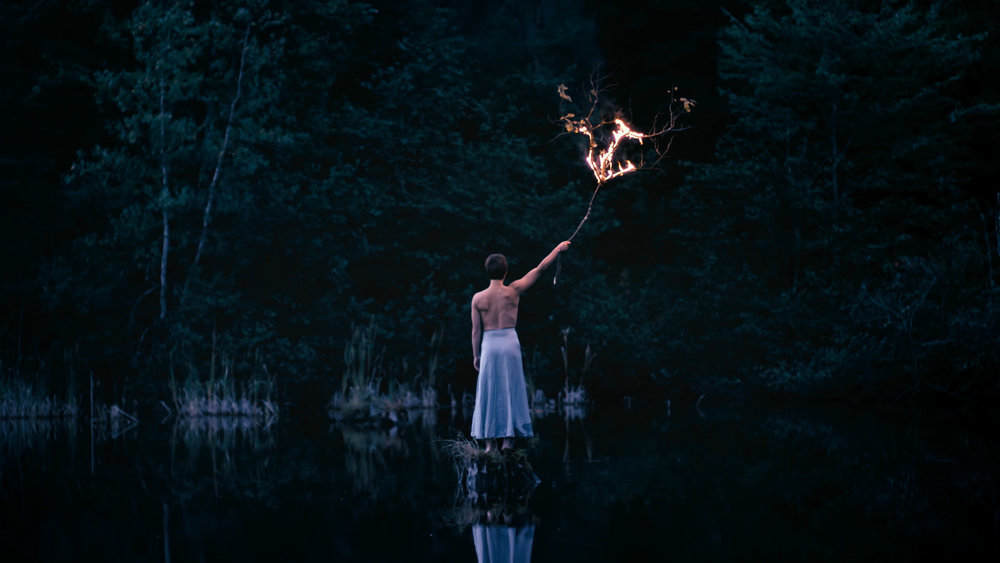
© Photos – François Gamache
Alan Lake Factori[e] is a multidisciplinary contemporary dance company based in Quebec, founded in 2007 by choreographer and filmmaker Alan Lake. The latter develops an approach that lies at the crossroads of dance, cinema, and visual arts. This intersection directly contributes to defining the company’s unique language, giving rise to raw and symbolist worlds in which the human, deeply immersed in its environment, evolves. The company is also dedicated to promoting contemporary dance and choreographic research through performances, workshops, training sessions, conferences, and other related activities. Deeply engaged in the dance community in Quebec, the company undertakes ambitious projects that contribute to the vibrancy of this art in the national capital and beyond.
All hailed by critics and the audience, its works enjoy increasingly widespread diffusion. Thus, the projects “Chaudière, déplacement et paysages” (2009) and “Là-bas le lointain” (2012) each give birth to a film and a stage work, and are notably broadcasted by La Rotonde in Quebec. In 2015, the performance “Ravages,” presented in Montreal and Quebec, pushes even further the approach proposed in previous creations. This time, two dance films emerge from the project: “Jardins-Catastrophes” (2014), which is broadcasted in Quebec and various countries, and “Ravages” (2015), a multi-award-winning film that is currently circulating in festivals around the world. In 2016, the “in situ” creation “Les Caveaux,” an audacious piece created and presented in an old abandoned warehouse in Limoilou, opens La Rotonde’s final season. Subsequently, Alan Lake Factori[e] continues its research by creating “Le cri des méduses” (2018), a colossal project that unfolds as a dance film and a large-scale production inspired by Théodore Géricault’s famous painting “The Raft of the Medusa.” In 2021, Alan presents to the public “Le Cycle des parades,” a multidisciplinary work that immerses him at the crossroads of dance, cinema, and visual arts. At the heart of this ambitious project are three artistic traces, three distinct forms of expression (an in situ performance, a film, and a stage show) that continually feed, enrich, and communicate with each other to create a choreographic trilogy that reveals to the spectators a raw and symbolist universe. From this exploratory work, “L’effritement des parades” (The Crumbling of Parades) was born, the choreographer’s fourth stage work. In 2023, as his previous works ‘Le cri des méduses’ and ‘L’effritement des parades’ continue to travel around the world, he embarks on the creation of his new large-scale piece ‘Orphée’ in collaboration with Théâtre du Trident.

© Photos – François Gamache
A few words from Alan Lake
I explore the close relationship that the body maintains with its environment. Therefore, my works always take root in chosen locations for their evocative powers. Standing within this “in situ” context, dance becomes inseparable from an environment with which it is in constant interaction. From this initial creative phase, the result is either a dance film or a live presentation on-site. Subsequently, I proceed to transpose this initial work for its dissemination in a performance venue. I endeavor to establish, through a scenography that combines sculptural installations, raw materials, and video projections, a space where the essence of the previously engaged location merges with the scenic parameters. This new environment allows me to renew my inquiry into the interrelation between dance, territory, visual art, and moving imagery. My stagings then reveal traces of a vanished past that align with the wilderness, subtly establishing the foundations of sanctuaries. It’s within these arenas that my choreographic writing gives form to peculiar pagan rituals, where performers fervently engage in exploring the immediacy of the body, its breath, flesh, and joints. They seek to comprehend their own presence while evolving in the presence of the other.
Throughout this process, I use the notion of “landscape” for its pictorial and evocative functions. I extract from the body and materials their “landscape” values to uncover what kinds of realities can be unveiled: order and disorder, the tragic and the magnificent, the polarity of the real. Over time, the evocation of the cycle of life and death has become recurrent in my approach. Through this theme, I speak of loss, traces, the sublime, and bodily memory.

